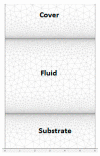Simulation of the Slip Velocity Effect in an AC Electrothermal Micropump
- PMID: 32878031
- PMCID: PMC7569861
- DOI: 10.3390/mi11090825
Simulation of the Slip Velocity Effect in an AC Electrothermal Micropump
Abstract
The principal aim of this study was to analyze the effect of slip velocity at the microchannel wall on an alternating current electrothermal (ACET) flow micropump fitted with several pairs of electrodes. Using the finite element method (FEM), the coupled momentum, energy, and Poisson equations with and without slip boundary conditions have been solved to compute the velocity, temperature, and electrical field in the microchannel. The effects of the frequency and the voltage, and the electrical and thermal conductivities, respectively, of the electrolyte solution and the substrate material, have been minutely analyzed in the presence and absence of slip velocity. The slip velocity was simulated along the microchannel walls at different values of slip length. The results revealed that the slip velocity at the wall channel has a significant impact on the flow field. The existence of slip velocity at the wall increases the shear stress and therefore enhances the pumping efficiency. It was observed that higher average pumping velocity was achieved for larger slip length. When a glass substrate was used, the effect of the presence of the slip velocity was more manifest. This study shows also that the effect of slip velocity on the flow field is very important and must be taken into consideration in an ACET micropump.
Keywords: AC electrothermal; microfluidics; micropump; slip velocity.
Conflict of interest statement
The authors declare no conflict of interest.
Figures











References
-
- Bottausci F. DNA hybridization enhancement in microarrays using AC-electrothermal flow; Proceedings of the ASME 2008 Fluids Engineering Division Summer Meeting Collocated with the Heat Transfer, Energy Sustainability, and 3rd Energy Nanotechnology Conferences; Jacksonville, FL, USA. 10–14 August 2008; pp. 629–636.
-
- Cao J., Cheng P., Hong F. Applications of electrohydrodynamics and Joule heating effects in microfluidic chips: A review. Sci. China Ser. E Technol. Sci. 2009;52:3477–3490. doi: 10.1007/s11431-009-0313-z. - DOI
-
- Doh I., Cho Y.-H. A continuous cell separation chip using hydrodynamic dielectrophoresis (DEP) process. Sens. Actuators A Phys. 2005;121:59–65. doi: 10.1016/j.sna.2005.01.030. - DOI
Grants and funding
LinkOut - more resources
Full Text Sources

